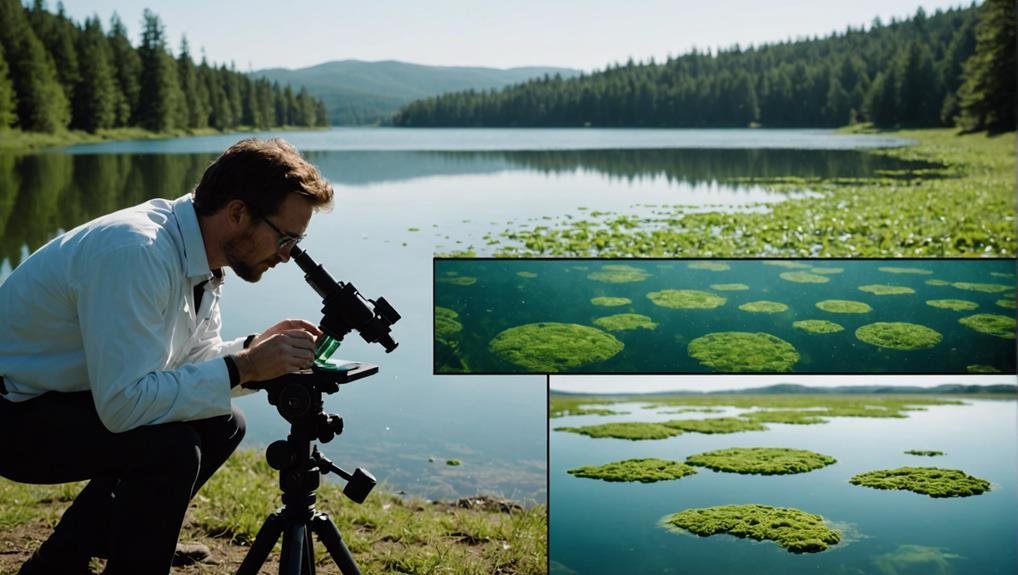Water testing plays a crucial role in managing algae by helping us monitor key factors like pH levels, nutrient concentrations, and bacterial presence. By regularly testing the water, we can detect harmful algae growth at an early stage.
Some of the links in this article may be affiliate links. If you make a purchase through these links, we may earn a small commission at no extra cost to you. Thank you.
Utilizing tools such as a Secchi disk for water clarity and photometers for nutrient analysis is vital for gaining insights into algae dynamics. Advanced techniques like QPCR and ELISA can help identify toxins, which in turn informs our response strategies.
Ultimately, water testing is essential for developing effective mitigation strategies based on data, ensuring the protection of ecosystems and public health. To delve deeper into how these methodologies contribute, further exploration is encouraged.
Importance of Water Testing
Regular water testing is crucial for managing algae and maintaining the health of our pond ecosystems. As pond owners, it's vital to prioritize monitoring water quality to ensure the overall well-being of our ponds. Through consistent testing, we can measure important factors like pH levels, nutrient concentrations, and bacterial presence, all of which play a key role in preventing harmful algae growth.
By conducting regular water testing, we can detect potential issues early on and take preventive measures before they escalate into more significant problems, such as algal blooms. These blooms can release toxins that are harmful to aquatic life, underscoring the importance of prompt detection and management.
Additionally, maintaining high water quality through regular testing is essential for the long-term health and vitality of our ponds, ultimately saving time and costs by preventing water quality deterioration and the need for extensive interventions.
Water testing also assists in identifying different types of algae, enabling us to implement targeted strategies for effective management. In essence, regular water testing is a fundamental practice for all pond owners to sustain thriving and safe pond ecosystems.
Methods for Algae Detection
Algae detection methods vary, from filtration and microscopy to tools like the Secchi disk for measuring water clarity. Filtering water samples helps collect algae, which can then be analyzed under a microscope to identify different species, providing insights into the algae diversity in water bodies.
The Secchi disk, a simple yet effective tool, is used to measure water transparency. It's submerged into the water until it becomes invisible, with decreased transparency often indicating higher algae concentrations. This tool helps in assessing the environmental presence of algae species.
Analyzing nutrient levels, specifically nitrates and phosphates, using a photometer is crucial in understanding the factors influencing algae growth. These nutrients, often originating from agricultural runoff, play a key role in algae proliferation. Monitoring these levels enables us to predict and manage algae blooms more effectively.
Recognizing algae diversity and environmental populations is essential for developing targeted management approaches. Different algae species can impact water quality differently, underscoring the importance of accurate identification for tailored responses.
Reliable water testing and algae detection methods are fundamental in preserving healthy aquatic ecosystems and ensuring water quality safety.
Identifying Cyanotoxins

Detecting cyanotoxins in water bodies is crucial for assessing health risks and protecting aquatic environments. Cyanotoxins, produced by cyanobacteria or blue-green algae, can pose serious threats to both humans and wildlife. To accurately identify these toxins, we utilize advanced methods such as QPCR and ELISA.
QPCR, short for Quantitative Polymerase Chain Reaction, is instrumental in pinpointing specific genes in water samples that indicate the potential presence of cyanotoxins. This method is essential for predicting the types of toxins that may be in the water.
Conversely, ELISA, which stands for Enzyme-Linked Immunosorbent Assay, is employed to detect and quantify particular cyanotoxins like Microcystin, Cylindrospermopsin, and Saxitoxin directly in the water samples.
By employing these sophisticated techniques, we can swiftly and accurately determine the existence of harmful cyanotoxins. This knowledge is crucial for understanding the associated health risks linked to contaminated water bodies. For example, Microcystin can cause liver damage, Cylindrospermopsin may impact kidney function, and Saxitoxin is a potent neurotoxin.
The rapid identification facilitated by QPCR and ELISA enables us to promptly implement effective management strategies, thereby safeguarding public health and the well-being of aquatic ecosystems. Precise and efficient water testing serves as our primary defense against the dangers posed by cyanotoxins.
Data-Driven Mitigation Strategies
Regular water testing is crucial for developing targeted strategies to control harmful algae in ponds. By analyzing the data from these tests, we can pinpoint the specific types of algae present and understand the environmental factors contributing to their growth. This information helps us tailor mitigation efforts to address the root causes of algal blooms effectively.
For example, if high nutrient levels are identified through water testing, we can take steps to reduce these nutrients. This may involve adjusting agricultural practices in the surrounding area or utilizing aeration techniques to enhance water quality.
Protecting Ecosystems and Health

Regular water testing plays a crucial role in safeguarding both ecosystems and public health by detecting harmful algae blooms early on. By continuously monitoring water quality, we can promptly identify and address harmful algal blooms in ponds or lakes before they inflict significant harm. These blooms can release algal toxins that are detrimental to aquatic plants and animals. Through early detection via water testing, we can implement effective algae control measures to preserve the well-being of our surface water bodies.
Human activities often contribute to the accumulation of nutrients in water, which can spur the growth of harmful algae. Routine testing enables us to comprehend these impacts and take necessary corrective actions. For instance, by mitigating nutrient runoff from agriculture or wastewater sources, we can prevent the conditions conducive to harmful algal blooms.
Protecting water quality isn't only crucial for the environment but also for public health. Algal toxins have the potential to contaminate drinking water and recreational waters, thereby posing risks to human health. By diligently conducting water testing, we can minimize exposure to these toxins, ensuring the safety of our communities and the delicate equilibrium of aquatic ecosystems.
Regular water testing stands as an indispensable tool in upholding both ecological stability and public safety.
Conclusion
Consistent water testing plays a crucial role in managing algae, much like tending to a delicate ecosystem in a garden. By regularly testing water quality, we can detect harmful cyanotoxins early and implement data-driven strategies to safeguard both the environment and our health.
Just as a gardener knows when to water and prune, monitoring and managing water quality is essential. This proactive approach helps maintain balanced and safe ecosystems for all living beings.
By staying vigilant with water testing, we can prevent algae from overtaking our aquatic environments. Through early detection of cyanotoxins, we can take necessary actions to protect the ecosystem and prevent harm to humans and wildlife.
It's like being a diligent gardener, ensuring that our water systems remain healthy and thriving. With the right tools and methods, such as regular testing and proper management practices, we can keep our water bodies free from harmful algal blooms.

